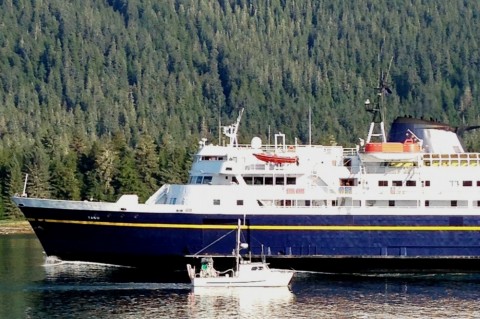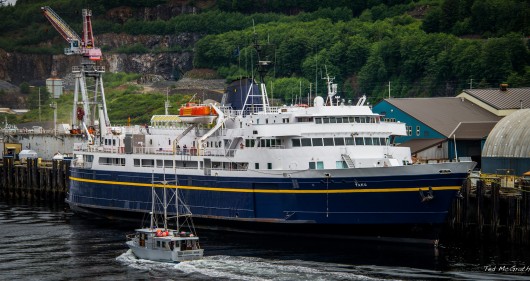
A Petersburg fishing boat passes the ferry Taku near the entrance of Wrangell Narrows in August, 2013. (Ed Schoenfeld/CoastAlaska News)
The Alaska Marine Highway System is moving ahead with plans to sell or scrap the ferry Taku. But it’s keeping its options open for a second sidelined ship, the Chenega. The vessels were discussed at Monday’s Marine Transportation Advisory Board meeting.
The Taku has been tied up for more than a year, with no plans for its return.
But the state can’t just put the 350-passenger ship on Craigslist or eBay — or run ads in newspapers or trade publications. It has to jump through some administrative hoops.
Ferry chief Mike Neussl said one is permission from the Federal Highway Administration, a major funding source.
“We’re received that, just recently, and are now working with the Department of Law on the actual procedures necessary to declare that vessel excess and dispose of it through the proper channels, either by sale or scrapping the vessel,” he said.
The state used the online auction site eBay to sell the 230-passenger ferry Bartlett in 2003. The price was just under $400,000. Officials at the time said it would cost $5 million to $6 million to bring it into compliance with new safety regulations.
The Taku has been appraised for sale as a working vessel and for scrap metal. Officials aren’t releasing those figures.

The fast ferry Chenega pulls into the Whittier terminal in September, 2011. It’s been sidelined indefinitely. (Photo by Ed Schoenfeld/CoastAlaska News)
The state is taking a different approach to a second sidelined vessel, the fast ferry Chenega, which tied up this fall.
Neussl says its future hasn’t been determined. But it will cost more than $1 million to bring it back to service.
“As every day goes by, additional licenses and certificates expire that will need to be updated as part of the process of bringing it back online,” he said.
He says the ship needs an overhaul and the water jets that power it need work.
Ferry General Manager Capt. John Falvey says top fast-ferry staffers also need special certifications.
“When you get a boat laid up like that, a lot of these officers and the mates and engineers, they’re gravitate to other ships. They’re going to lose those certifications,” he said.
Neussl says the state budget cuts led to a schedule that doesn’t require all of the system’s 11 ferries.
“One of the ways to reduce operating costs and not impact greatly the level of service provided is to reduce the size of the fleet,” he said.
The marine highway is spending about half-a-million dollars a year tying up the two ships.
The 11-year-old Chenega is being stored in a Tacoma, Wash., shipyard. It was taken out of service because it requires more fuel, making it more expensive to run than most other ships. It’s sister ship, the Fairweather, is still in use, but doesn’t operate as often as it used to.
The 53-year-old Taku is docked in Ketchikan’s Ward Cove. It was removed from service because of its age and it doesn’t fit into the highway’s long-term plans.






